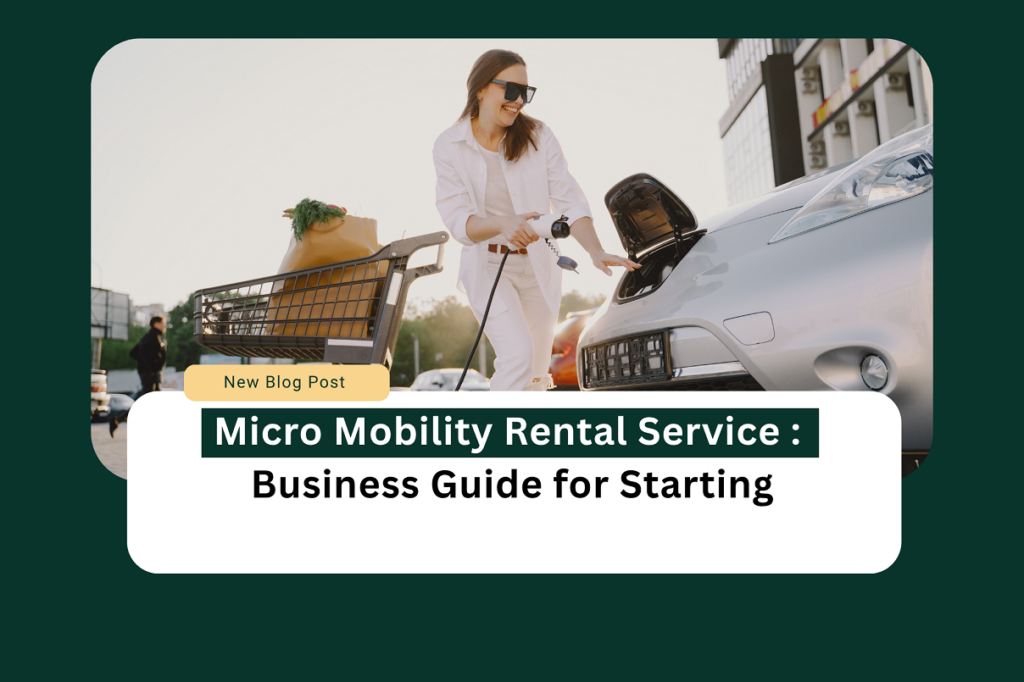Introduction
Micro mobility rental services have revolutionized urban transportation while generating profitable business prospects for entrepreneurial individuals. The shared electric scooter and bike and small vehicle programs address consumer needs for convenient eco-friendly and affordable transportation options. The micro-mobility market is expected to grow to $214 billion by 2030 according to McKinsey & Company which makes it an optimal moment to establish a business in this active sector. This guide presents a complete method for starting a profitable micro mobility rental service in the American market through an organized path from business concept to operational success.
Step 1: Conduct Market Research
Your micro-mobility business requires a comprehensive market research phase as its starting point. Select cities that have friendly regulations together with sufficient bike infrastructure and a user base consisting of tech-savvy urban residents mainly between 25 and 34 years old. The National Association of City Transportation Officials (NACTO reports that micro mobility trips primarily take place in urban areas where the main users belong to the 25-34-year-old age group. Examine the factors that include population density alongside average commute distances, existing public transportation networks, and climate conditions. Your business can identify market gaps by studying competitors in target areas through analysis of their vehicle fleets along with pricing models and service regions.
Step 2: Develop Your Business Model
Build a thorough business model that explains your operational framework alongside your revenue generation approach after selecting valuable markets. Your company must determine whether to operate with docked stations that require vehicles to return to fixed locations or to implement a dockless system that lets riders end their trips at any point in the service area. Your pricing plan should contain options between unlocking fees with per-minute billing or subscription plans and day passes and corporate agreements. The Boston Consulting Group reveals operational costs absorb between 50-65% of total revenue so efficient operations become essential for achieving profitability. The business model requires comprehensive financial planning to show startup expenses alongside operational costs with revenue predictions and profit achievement timelines.
Step 3: Navigate Regulatory Requirements
The process of obtaining required permits while satisfying local regulations stands as a major hurdle when starting a micro-mobility service. The Shared-Use Mobility Center research indicates that 70% of significant U.S. cities have established particular rules for micro-mobility service operations. The regulatory requirements encompass operating permits with fees along with fleet restrictions and vehicle standards and liability insurance ranging from $1 to $5 million and operational zones and parking rules. Meet with city officials in advance to show how your business resolves current mobility problems and how you operate with safety at the forefront.
Step 4: Select and Procure Vehicles
Select vehicles that match your business structure, market segment requirements, and financial capability. The selection between electric scooters, electric bikes, and electric mopeds depends on initial cost and lifespan duration. The research in Transportation Research Part D shows that shared electric scooters used heavily will survive about 4.6 months before needing replacement so fleet replacement requires thorough financial preparation. Choose vehicles that meet weather conditions and have long battery life while being easy to maintain and providing comfort for users. Start your fleet with vehicles according to industry standards of 10-15 vehicles for every 1,000 residents in your service area.
Step 5: Build Technology Infrastructure
Create an advanced technological infrastructure that enables users to create accounts, view vehicles, unlock them, and process payments through their mobile devices. The system needs a backend management system to track fleet schedule maintenance and perform business analytics. The development of technology should involve options such as bespoke solutions, white-label platforms, or third-party platforms that offer revenue-sharing models. Your platform requires features that include geofencing for regulatory compliance alongside user verification to stop unauthorized use and analytics tools for operational optimization. The application of advanced analytics at UC Berkeley has demonstrated its ability to boost fleet utilization rates by 35% which generates substantial profit gains.
Step 6: Establish Operational Procedures
The business needs detailed operational procedures that cover vehicle deployment and rebalancing steps, charging methods and maintenance protocols. Decide between operating with staff members or working with independent contractors through a gig economy structure for your operations management. The company should create plans to handle typical operational issues that result in vehicle theft and vandalism that impact 10-15% of annual fleet numbers and require strategies for battery management in extreme weather conditions and handling seasonal ridership changes. The company needs to create detailed customer service procedures that outline both user inquiry response times and complaint resolution steps. The company should establish thorough safety protocols through scheduled vehicle inspections and proactive maintenance plans that protect riders and adhere to regulatory standards.
Step 7: Launch Marketing and User Acquisition
Develop comprehensive marketing strategies to build your user base quickly upon launch. According to CB Insights, customer acquisition costs in the micro-mobility industry average $30-40 per user. Effective approaches include targeted digital marketing in operational zones, introductory ride promotions, partnerships with local businesses and universities, and referral programs that incentivize existing users to recruit new customers. Focus on communicating your unique value proposition—whether superior vehicle quality, better availability in specific neighborhoods, or integration with public transit. Community outreach programs and rider education initiatives about safe practices can build goodwill while expanding your user base.
Conclusion
Starting a micro-mobility rental service requires careful planning across multiple dimensions: market selection, business modeling, regulatory compliance, vehicle procurement, technology development, operational excellence, and strategic marketing. By following this step-by-step approach, entrepreneurs can position their businesses for sustainable growth in this rapidly evolving industry. The micro-mobility sector continues to mature, with increasing emphasis on sustainability, safety, and integration with broader transportation networks. As you develop your business, identify specific market niches or underserved communities that may offer the most promising path to success.
We welcome your feedback about this guide and encourage you to share your experiences with the growing community of micro-mobility entrepreneurs on social media.
FAQ
What’s the average startup cost for a micro-mobility rental service? Initial investments typically range from $250,000-$500,000 depending on fleet size and market.
Which cities have the most favorable regulations? Medium-sized cities with progressive transportation policies like Portland, Austin, and Columbus.
What’s the typical vehicle lifespan? E-scooters: 3-6 months; E-bikes: 12-24 months in regular use.
How do I prevent vehicle theft? Use GPS tracking, anti-theft hardware, and geofencing technology.
What’s the average customer acquisition cost? Approximately $30-40 per active user.
Read More : Vertical farming startup business model








